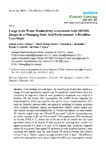Por favor, use este identificador para citar o enlazar este ítem:
http://www.alice.cnptia.embrapa.br/alice/handle/doc/971815Registro completo de metadatos
| Campo DC | Valor | Lengua/Idioma |
|---|---|---|
| dc.contributor.author | TEIXEIRA, A. H. de C. | pt_BR |
| dc.contributor.author | SCHERER-WARREN, M. | pt_BR |
| dc.contributor.author | HERNANDEZ, F. B. T. | pt_BR |
| dc.contributor.author | ANDRADE, R. G. | pt_BR |
| dc.contributor.author | LEIVAS, J. F. | pt_BR |
| dc.date.accessioned | 2013-11-21T11:11:11Z | pt_BR |
| dc.date.available | 2013-11-21T11:11:11Z | pt_BR |
| dc.date.created | 2013-11-21 | pt_BR |
| dc.date.issued | 2013 | pt_BR |
| dc.identifier.citation | Remote Sensing, v. 11, n. 3, p. 5783-5804, 2013. | pt_BR |
| dc.identifier.isbn | 2072-4292 | pt_BR |
| dc.identifier.uri | http://www.alice.cnptia.embrapa.br/alice/handle/doc/971815 | pt_BR |
| dc.description | In the Brazilian semi-arid region, the intensification of agriculture results in a change of natural vegetation by irrigated crops. To quantify the contrast between these two ecosystems, the large-scale values of water productivity components were modelled in Petrolina (PE) and Juazeiro (BA) municipalities. The SAFER (Simple Algorithm For Evapotranspiration Retrieving) algorithm was used to acquire evapotranspiration (ET), while the Monteith's radiation model was applied for estimating the biomass production (BIO). Moderate Resolution Imaging Spectroradiometer (MODIS) satellite images were used together with agro-meteorological data. In Petrolina and Juazeiro, the mean monthly ET values for irrigated crops were 938 and 739 mm·month−1, with the corresponding ones for natural vegetation of 385 and 194 mm·month−1.Water productivity (WP) was analysed by the ratio of BIO to ET, defined here as the ratio of the net benefits from the mixed agricultural systems to the amount of water required for producing those benefits. The highest incremental WP values, as a result of the irrigated crops introduction, happened outside the rainy period. More spatial WP uniformity occurred in natural vegetation, when comparing with irrigated crops. The most frequent WP values in Petrolina were between 1.6 and 2.2 kg·m−3 while in Juazeiro this range was from 1.0 to 1.6 kg·m−3. The differences between the municipalities can be mainly explained by differences in precipitation and soil water storages conditions, promoting better rainfall use efficiency by the natural vegetation in the first one. The results of the current research are important for appraising the land use change impacts in situations of expanding irrigation areas. | pt_BR |
| dc.language.iso | por | pt_BR |
| dc.rights | openAccess | pt_BR |
| dc.subject | Net radiation | pt_BR |
| dc.subject | Surface resistance | pt_BR |
| dc.title | Large-scale water productivity assessments with MODIS images in a changing semi-arid environment: a Brazilian case study. | pt_BR |
| dc.type | Artigo de periódico | pt_BR |
| dc.date.updated | 2013-11-21T11:11:11Z | pt_BR |
| dc.subject.nalthesaurus | Evapotranspiration | pt_BR |
| dc.subject.nalthesaurus | Biomass production | pt_BR |
| riaa.ainfo.id | 971815 | pt_BR |
| riaa.ainfo.lastupdate | 2013-11-21 | pt_BR |
| dc.identifier.doi | 10.3390/rs5115783 | pt_BR |
| dc.contributor.institution | ANTONIO HERIBERTO DE C TEIXEIRA, CNPM; MORRIS SCHERER-WARREN, ANA; FERNANDO B. T. HERNANDEZ, UNESP; RICARDO GUIMARAES ANDRADE, CNPM; JANICE FREITAS LEIVAS, CNPM. | pt_BR |
| Aparece en las colecciones: | Artigo em periódico indexado (CNPM)  | |
Ficheros en este ítem:
| Fichero | Descripción | Tamaño | Formato | |
|---|---|---|---|---|
| remotesensing0505783.pdf | 1,46 MB | Adobe PDF |  Visualizar/Abrir |









